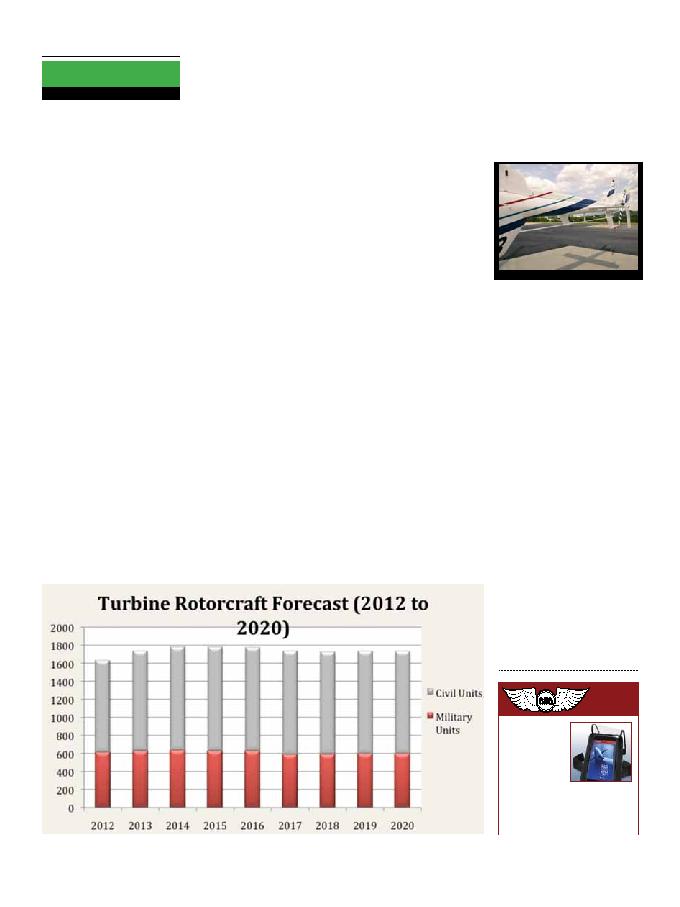
40
GA
/ Vol. 5 / No. 2 / FEBRUARY 2013
Soaring to new
heights:
The rise of
the global
rotorcraft
market
In the scope of both civil and mili-
tary aviation, the global helicopter
market is set to maintain the tena-
cious growth it has experienced
over the past five years. Indeed,
current forecasts suggest that by
2017 the industry will be worth an
estimated $24.7 billion. Underly-
ing the surge in demand for new
rotorcraft has been the broadened
appetite for helicopter use in vari-
ous growth sectors of the global
economy. Moreover, the replace-
ment cycles of aging helicopter
fleets are being propelled by rising
levels of disposable income in
emerging markets. For expanding
and newly established helicopter
operators, ensuring the effective
long-term service of rotorcraft
will require, among other fac-
tors, revised approaches to parts
supply management.
Based on the forecasts of
the existing Rolls Royce 10-year
helicopter market outlook, a
total of 16,970 turbine rotorcraft
deliveries worth $140 billion are
anticipated by 2020, including
10,900 for civil application and
by
Zilvinas Sadauskas
Helicopter News
6,070 for military use. Driving these
orders are enhanced civil market
fundamentals and a growing call by
the world's defence organisations
for the vertical lift capability
afforded by helicopters. Precisely,
recent years have seen a stronger
dependency on helicopters for use
in offshore oil and gas operations,
emergency medical services (EMS)
and by law enforcement agencies.
In addition, what has conventionally
been an industry focused on the
industrialised nations of Europe and
North America has begun to undergo
a shift in its customer base, with
the Asia-Pacific region expected to
dominate expanding sales figures
over the next five years.
What we are seeing here is a
budding recognition of the practical
value served by helicopters. Much
of this is driven by tremendous
advancements in technology over
the past decade, affording both
reductions in operating costs and
improvements to safety and overall
efficiency. Indeed, these forward
strides appear to be acting as a
catalyst for the replacement of aging
helicopter fleets worldwide, affecting
both civil and military segments. In
particular, China's helicopter market,
which is severely underdeveloped at
the current time, is expected to see
double-digit growth over the coming
few years. To place it is perspective,
there are roughly 300 civil rotorcraft
registered in the country today,
as compared to the 8,000 or so
operating in Europe.
Fuelling China's rotorcraft
market is the demand for helicopters
in the country's burgeoning offshore
oil industry. However, the increasing
practicality of helicopters in remote
business engagements is being felt
further afield too. For a number of
years, the growth of the helicopter
sector has outperformed other
segments of the Australian aviation
industry, with the current number of
helicopters forecast to double in as
little as seven years. Conducive to
this growth has been the accelerating
regional demand for the country's
energy and mineral reserves.
The maturing helicopter markets
in emerging economies may also
spell changes to the dominant
players of the industry. For instance,
Eurocopter has been expanding its
sales, production and maintenance
operations in China, reporting an
upshot of 40 percent market share
in the product segments for which it
competes. Furthermore, last week's
highly publicised joint venture
agreement between India's Elcom
Systems and Russian Helicopters
to assemble Mi and Kamov brand
helicopters in India is likely to
shape further change to the industry
dynamics of the region.
With the continued expansion
of the rotorcraft industry comes the
question of component supply. For
many helicopter operators, their
primary business focus has about
as much to do with aviation as a
racehorse has to deep sea diving.
From a functional and cost-saving
perspective, such circumstances
would warrant an integrated
component supply system in order
to save time and deliver prompt
solutions in AOG situations. Indeed,
current e-procurement systems
afford operators the opportunity
to streamline their component
supply process, allowing them to
concentrate on more fundamental
duties, such as emergency
medical relief. ·
Chart 1: Rolls Royce turbine rotorcraft forecast
During January this year Bell
Helicopter, under its Aeronautical
Accessories brand, announced it
had received FAA/STC approval
for an HF Antenna for the Bell 407
helicopter model.
The HF antenna is designed to
interface with many types of HF
radios, thereby increasing reception
in remote areas, improving safety
and communications. A "towel
bar style," the HF antenna runs
the full length of the underside of
the tailboom.
"We are seeing a tremendous
amount of interest in the new Bell
407 HF Antenna Kit," Jennifer
Lunceford, manager, Sales for
Aeronautical Accessories said. "As
helicopters perform missions in
areas beyond the range of traditional
radio equipment, the HF antenna
is required. We are pleased that
Bell Helicopter has received the
STC approval and look forward to
responding to industry demand with
this new product."
Additional information on the
407 HF Antenna Kit is available
on Aeronautical Accessories
website, aero-access.com, or contact
the Aeronautical Accessories
sales team at 1.800.251.7094 or
sales@aero-access.com. ·
Bell Helicopter
receives 407 HF
Antenna STC
approval, available
through Aeronautical
Accessories
GENERAL
PILOT
SUPPLIES
Visit http://www.asa2fly.com/za to view
ASA products, many stocked locally in
Johannesburg, South Africa at General Pilot Supplies.
Tel:+27(0)114624601·Email:mw17@mweb.co.za
GenPilotSupplies-GlobalAviator.indd 1
2/24/12 3:14 PM

